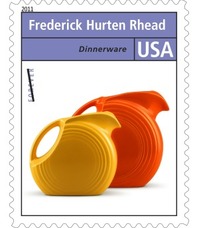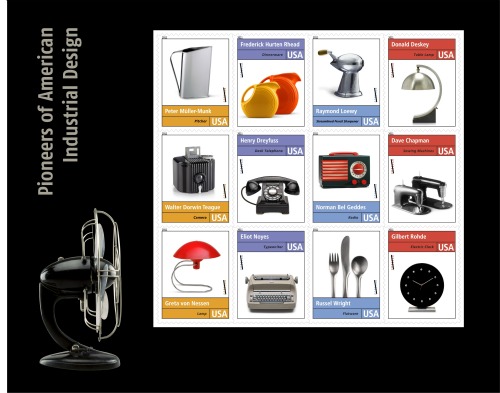Late last month, the U.S. Postal Service issued a new sheet of stamps that, while not quite as good as the ones I wrote about last year honoring Abstract Expressionists, are a boon to the art world nonetheless.
 These stamps honor industrial design masters, and the USPS chose the Cooper-Hewitt National Design Museum as the setting for the dedication. The designers honored include Peter Müller-Munk, Frederick Hurten Rhead, Raymond Loewy, Donald Deskey, Walter Dorwin Teague, Henry Dreyfuss, Norman Bel Geddes, Dave Chapman, Greta von Nessen, Eliot Noyes, Russel Wright and Gilbert Rohde.
These stamps honor industrial design masters, and the USPS chose the Cooper-Hewitt National Design Museum as the setting for the dedication. The designers honored include Peter Müller-Munk, Frederick Hurten Rhead, Raymond Loewy, Donald Deskey, Walter Dorwin Teague, Henry Dreyfuss, Norman Bel Geddes, Dave Chapman, Greta von Nessen, Eliot Noyes, Russel Wright and Gilbert Rohde.
Each stamp feature the designer’s name plus a photograph of the pitcher, phone, typewriter or other object he/she created and the year or years when it was created.
The press release making the announcement contained a short history of design:
Industrial design emerged as a profession in the United Sates in the 1920s, but really took off during the Great
Depression. Faced with decreasing sales, manufacturers turned to industrial designers to give their products a modern look that would appeal to consumers. Characterized by horizontal lines and rounded shapes, the new, streamlined looks differed completely from the decorative extravagance of the 1920s. The designs evoked a sense of speed and efficiency and projected the image of progress and affluence the public desired.
Consumer interest in modern design continued to increase after World War II, when machines allowed corporations to mass produce vacuums, hair dryers, toasters and other consumer goods at low cost. Industrial designers helped lower costs further by exploiting inexpensive new materials like plastic, vinyl, chrome, aluminum and plywood, which responded well to advances in manufacturing such as the use of molds and stamping….
Even as streamlining gave way to new looks in the 1960s, the groundbreaking work of industrial designers continued to transform the look of homes and offices across the country. Today, industrial design remains an integral component of American manufacturing and business, as well as daily life.
Here’s a link to a background PDF with more detailed information about each designer. And here’s what the full sheet looks like:

I think this is all great — the more good art and design out there, the better.
Photo Credits: Courtesy of the USPS
